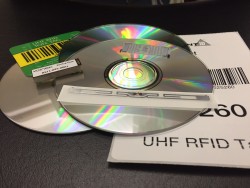A Sad (but Funny) Comparison of RFID vs. DVD Adoption
By Jack Romaine
Originally published at RFID Journal
Adoption rates for passive ultrahigh-frequency (UHF) RFID have been a disappointment to anyone with any knowledge of the industry. To understand why that is the case, let’s take a look at one of the most rapid and successful product introductions of any consumer electronics technology in history—the video transition from VHS tapes for VCRs to DVD disks—and alter it to resemble the RFID buying experience.
First, let’s examine some data:
Source: Consumer Electronics Association, eBrain Market Research statistics
As with RFID, the consumable was more expensive than the current standard. Just as an RFID tag costs more than a bar code, the DVD was much more expensive than a VHS tape with the same content. The benefits of DVDs were very clear (better picture quality, no tracking problems, greater storage capacity and a longer life), and the industry educated consumers to the point at which the price premium was accepted. The RFID industry highlighted features (no line of sight requirement, rewriteability and durability), though it was not as clear about the benefits (a lower transaction cost to acquire data, data acquisition without human intervention, and the ability to be repeatedly reused, even in tough environments unsuitable for bar codes). But the real problem with RFID has been the system deployment.
As we all know, the migration from VCR to DVD went something like this:
You went to the electronics store, bought a DVD player costing $50 to $100, and brought it home. You hooked up a couple of cables that came with the player to your TV for video and sound, plugged it in with the supplied power cord, turned it on and hit “play.” Once you had the disk and player, you could install the device and be watching movies in less than 15 minutes.
It was easy, and it was successful.
Now let’s imagine the transition to DVD had been like the RFID industry. What would that look like?
You would go to the electronics store, pick out a DVD player costing $50 to $100 and put it in your cart. You would start to head for the register, and the clerk would say “But, wait! You need a new TV if you want that to work. Your old TV isn’t compatible. And not just any TV. You need a model from this $2,000-plus family.”
“Ok, I guess so,” you would say, and you’d then add the TV to the cart with the DVD player.
“But, wait!”, the clerk would say again. “You need a special computer to run the DVD player because it doesn’t have any built-in intelligence. And not just any computer! It has to be this high-end, $2,000-plus type.”
“Really?” you would say. “All this extra money to make a $50 player work?” But you really, really like movies, so you’d decide to go ahead and add the computer to your cart, and you’d start for the register once more.
“But, wait!” the clerk would again chime in.
“Really?” you would reply. “You’ve got to be kidding!” But unfortunately, he wouldn’t be.
“You need software to run that computer and tie into the DVD player and the TV. We don’t do that here, but I know a few guys you can call,” he would explain. “A few more thousand dollars and a couple weeks to get the software done, and you’ll be watching movies on that $50 DVD player! Of course, all of the devices need to be compatible, and you need to find the right software guy that works with those particular components.”
Would you still want DVDs?
When laid out this way, are you surprised that RFID hasn’t met with enthusiasm and has regularly failed to meet or exceed forecasts? Of course, I exaggerate a little—in the RFID market, you’d be hard-pressed to find someone who would actually help you select the components that go together!
So how do we fix this?
The RFID industry needs to stop focusing on reader and tag price as the problem, and instead integrate the features and intelligence that customers need to make it a usable product. No problems are solved with dumb terminal readers—they are solved with complete solutions. A complete RFID solution requires design, readers, antennas, tags, brackets or enclosures, cabling, RFID middleware, application software, software integration services, installation services and training. Let’s integrate more of these into an easy-to-buy package. In other words, we need more technology integration, and more solutions that combine hardware and software. Plus, we need more integrators with real RFID experience
If you are an end customer, seek out an experienced RFID systems integrator. Do this early, because proper design of the system is half the battle. Don’t deal with any integrator who tells you it has to be 100 percent RFID or nothing. The best system generally uses both RFID and bar codes. There are RFID solutions that are interoperable and backward-compatible with bar codes out there. Don’t deal with any integrator claiming that you need to replace your business-intelligence software—whether enterprise resource planning (ERP), asset tracking, warehouse-management system (WMS) or material requirements planning (MRP)—to make RFID work. There are RFID solutions that bolt directly onto your existing software without the need for additional software expense or the replacement of perfectly good infrastructure.
Jack Romaine is a member of the AIDC 100 and has decades of experience in automatic identification. He is the coinventor of a couple of integrated RFID solutions and an automated system of contactless dimensioning. Romaine started the RFID group at Accu-Sort Systems in 1997 and is now the CEO of Element ID Inc. He also worked as a sell-side financial analyst for SG Cowen, covering semiconductors and RFID, and was Bloomberg Markets Magazine’s Semiconductor Analyst of the Year in 2003.

